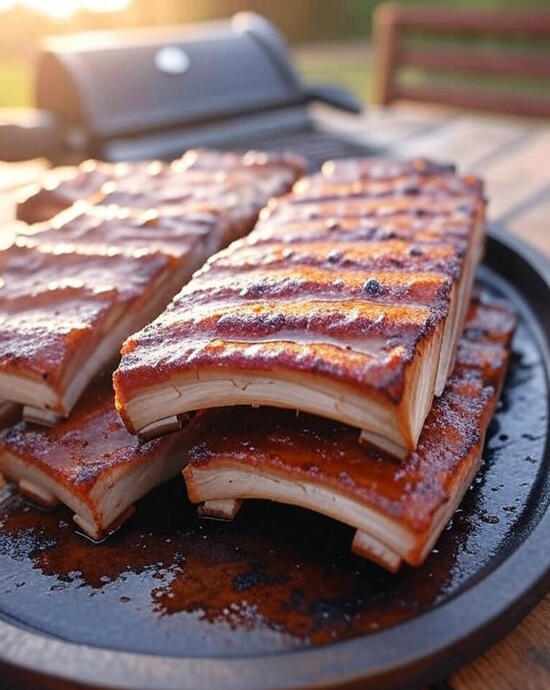- Step 1: Preparing the Ribs

To begin crafting delicious barbecue ribs, start with a quality rack of ribs. Lay the ribs bone-side up on a clean cutting board. Locate the thin, silvery membrane that covers the back of the ribs. This membrane can become tough and chewy during cooking, so it's best to remove it. Use a butter knife or a blunt object to lift a corner of the membrane, then grip it firmly with a paper towel and pull it off in one smooth motion. Removing this membrane will allow your rub and smoke to better penetrate the meat, resulting in more tender and flavorful ribs.
- Step 2: Applying the Dry Rub
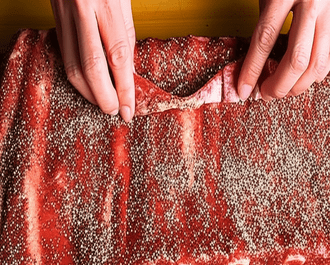
Now it's time to infuse the ribs with flavor using a dry rub. A good barbecue rub typically consists of a blend of spices such as salt, pepper, paprika, garlic powder, onion powder, and chili powder. You can either use a pre-made rub or create your custom blend to suit your taste preferences. Generously apply the dry rub to all surfaces of the ribs, pressing it into the meat to ensure it adheres well. Don't be shy with the rub – a good coating will create a flavorful bark during the smoking process. Once the ribs are fully coated, you can let them sit for at least 30 minutes, or even overnight in the refrigerator, to allow the flavors to meld with the meat.
- Step 3: Smoking the Ribs
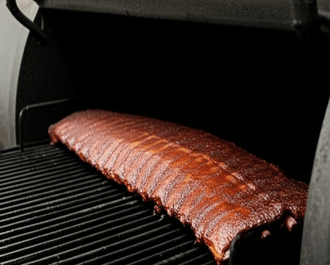
The heart of barbecue ribs lies in the slow-smoking process. Prepare your smoker according to the manufacturer's instructions, aiming for a consistent temperature of around 225-250°F (107-121°C). Use your preferred wood chips or chunks – hickory, mesquite, or fruitwoods like apple or cherry are popular choices for ribs, adding unique smoky flavors. Place the seasoned ribs bone-side down on the smoker grates. Close the lid and let them smoke undisturbed for approximately 2-3 hours. During this time, the smoke will penetrate the meat, and a flavorful bark will begin to form on the surface. Avoid opening the smoker too frequently to maintain a consistent temperature and smoke.
- Step 4: Wrapping the Ribs (Optional)
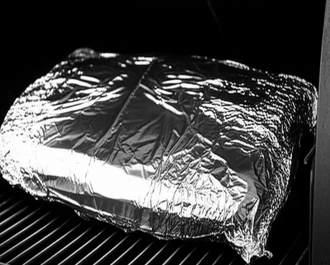
For extra tender and juicy ribs, many barbecue enthusiasts opt to wrap them during the cooking process, often referred to as the "3-2-1 method," where ribs are smoked for 3 hours, wrapped for 2 hours, and then unwrapped for 1 hour. After the initial 2-3 hours of smoking, place each rack of ribs on a large sheet of heavy-duty aluminum foil. You can add a splash of liquid, such as apple juice, broth, or even barbecue sauce, to the foil before sealing it tightly. Wrapping helps to braise the ribs in their juices, accelerating the cooking process and adding moisture. Return the wrapped ribs to the smoker for another 1-2 hours.
- Step 5: Saucing and Finishing

Once the wrapped ribs have cooked for another 1-2 hours and are tender to the touch, carefully unwrap them. At this stage, you can choose to sauce the ribs or leave them dry-rubbed. If you prefer sauced ribs, brush your favorite barbecue sauce generously over all sides of the meat. Return the unwrapped, sauced ribs to the smoker for a final 15-30 minutes. This allows the sauce to set and become slightly caramelized and sticky. Keep a close eye on them to prevent the sauce from burning. If you prefer dry ribs, you can skip the saucing step and simply proceed to serving once they are tender.
- Step 6: Resting and Serving
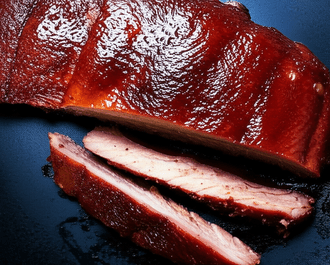
After the final stint in the smoker, remove the barbecue ribs and let them rest for 10-15 minutes before slicing and serving. Resting allows the juices to redistribute throughout the meat, resulting in even more tender and flavorful ribs. To serve, place the rack of ribs on a cutting board and use a sharp knife to slice between the bones. Serve the succulent barbecue ribs with your favorite sides, such as coleslaw, potato salad, cornbread, or baked beans, for a classic barbecue feast. Enjoy the smoky aroma and the mouthwatering taste of your homemade barbecue ribs!
- Optional Tips
Use apple cider vinegar or apple juice in the foil for added tenderness.
Marinate ribs overnight with the rub for deeper flavor.
Add a dash of liquid smoke for more barbecue aroma if not grilling.
- Calories:750 kcal
- Protein:40 g
- Fat:55 g
- Carbohydrates:25 g
- Sugar:15 g
- Fiber:1 g
- Sodium:900 mg
Barbecue ribs are a quintessential dish in American cuisine, celebrated for their smoky, tender, and flavorful profile. Whether prepared for a summer cookout or a cozy family dinner, mastering a barbecue ribs recipe is a rewarding endeavor for any home cook. The keyword “bbq ribs on the grill” emphasizes the classic method of cooking ribs over an open flame, which imparts a distinct charred flavor. In contrast, “barbecue ribs recipe” encompasses the broader preparation, including marinades, rubs, and sauces that elevate the dish. This overview explores the essentials of crafting mouthwatering barbecue ribs, focusing on grilling techniques, ingredients, and tips for success.
The foundation of a great barbecue ribs recipe lies in selecting the right cut. Pork ribs, particularly baby back or spare ribs, are popular choices due to their balance of meat and fat. Baby back ribs are leaner and cook faster, while spare ribs are meatier with a richer flavor. Preparation begins with removing the membrane from the back of the ribs to ensure tenderness. A dry rub, typically a blend of brown sugar, paprika, garlic powder, onion powder, cayenne, and black pepper, is applied generously to enhance flavor. For those seeking a deeper taste, marinating the ribs overnight in a mixture of apple cider vinegar, mustard, or even cola can tenderize the meat and add complexity.
Grilling is where the magic happens for “BBQ ribs on the grill.” Low and slow is the mantra for achieving fall-off-the-bone texture. Using indirect heat on a charcoal or gas grill at around 225–250°F (107–121°C) for 3–5 hours allows the collagen in the ribs to break down, resulting in tender meat. Wood chips like hickory or applewood can be added to the grill to infuse a smoky aroma. Basting the ribs with a mop sauce—a thin, tangy liquid of vinegar, apple juice, or beer—keeps them moist during cooking. For the final touch, a thick, glossy barbecue sauce, often tomato-based with molasses, honey, or brown sugar, is brushed on during the last 20–30 minutes to caramelize without burning.
A successful barbecue ribs recipe also hinges on technique. The “3-2-1 method” is a popular approach for spare ribs: 3 hours unwrapped on the grill, 2 hours wrapped in foil with a liquid like apple juice, and 1 hour unwrapped to set the sauce. For baby back ribs, a 2-2-1 method adjusts for their smaller size. Monitoring internal temperature (aim for 190–203°F or 88–95°C) ensures doneness without overcooking. Resting the ribs for 10–15 minutes after grilling allows juices to redistribute, enhancing flavor.

